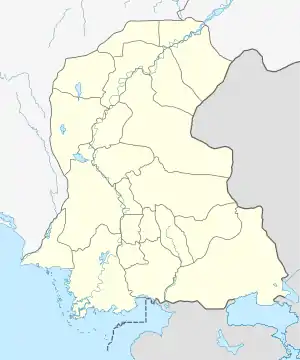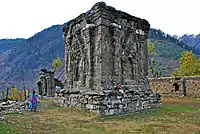Tando Allahyar
Tando Allahyar (ٽنڊوالهيار, in Sindhi, (Urdu ٹنڈو الہ یار ) is a city and capital of Tando Allahyar District located in Sindh, Pakistan. It is the 56th largest city of Pakistan by population according to the 2017 census. Notable people of the district are , Muhammed siddique Memon chief secretary Sindh . Abdul Sattar Bachani MNA. Syed Ali Nawaz shah MPA .
Tando Allahyar | |
|---|---|
 Tando Allahyar (in Sindhi) ٽنڊو الهيار | |
 Tando Allahyar | |
| Coordinates: 25°27′N 68°42′E | |
| Country | |
| Province | |
| Division | Hyderabad |
| District | Tando Allahyar |
| Population | |
| • City | 156,562 |
| • Rank | 56th, Pakistan |
| Time zone | UTC+5 (PST) |
History
Tando Allahyar was founded during the rule of Talpur, of the Mir clan. When Bachal Yousfani was mayor, inns and guest houses were built as well as colonies for residents and jobs were created.
Watayo Faqir's shrine
The shrine of the sindhi oracle and that man was presented thinks his own wisdom Sufi poet Watayo Faqir lies at Kuba Shareef near Rashidabad.
1790 fort construction
Tando Allahyar was founded in 1709 when Talpur constructed a mud and clay fort about 3 kilometres (1.9 mi) from the present day Tando Allahyar town center. The fort was built to provide security for the Mir and the people of the area. It also functioned as a trading post. As the township developed around the fort, it was known as "Allahyar Jo Tando" (Allahyar's Town). The fort is now called "Kacho Qilo". Some walls, decorated at the time of the Mir remain.
British rule
In 1906, during the British Raj, a railway station was established. It reflected the town's growing importance as a centre of agriculture and trade. The name of the town changed from "Allahyar Jo Tando" to "Tando Allahyar". The British Raj took the fort for its official use.
Canal

In 1933, a canal was constructed. It further increased Tando Allahyar's importance in agriculture and trade.
Independence
Prior to 1947, the majority of inhabitants of Tando Allahyar were Hindu. The temple of Baba Ramdevji Rama-Pir was a symbol of Hindu–Muslim unity and peaceful co-existence. After independence of Pakistan, many Hindu followers left. Nevertheless, the temple, located in the town centre, remains a popular destination for Hindu pilgrims.
The predominantly Muslim population supported Muslim League and Pakistan Movement. After the independence of Pakistan in 1947, the minority Hindus and Sikhs migrated to India while the Muslim refugees from India settled in the Tando Allahyar District.
Ramapir Temple
The Rama Pir Mandir is a temple of Ramdev Pir in Tando Allahyar. It is the second largest pilgrimage sites for the Hindus in Pakistan. Every year in Bhadrapada month of Hindu calendar, here the 3 days Mela arranged by Ramapir Sheva Mandli.[2]
Legend
According to a legend, about 150 years ago, a man of Khatri community of Tando Allahyar took a vow that if he was blessed with a son, he will arrange the "Mela" (fair) of Rama Pir in Tando Allahyar Sindh. As the wish of this Khatri community man was fulfilled, he brought an earthen lamp from the original temple of Rama Pir in today's Rajasthan, India to Tando Allahyar in today's Sindh, Pakistan and built a temple here. After worshiping to "Shree Ramapir" his wish was fulfilled and then he built this temple. In the mela carrying "Dajja" (flags) in their hands, they recite "Bhajans" whole night sitting outside the city and early in the morning at 5:00AM they hoist "Dajja" at the temple by dancing on the beat of drums and trumpets. Thousands of devotees, including man, women and children, traveled on foot to pay homage to Rama Pir. They had brought flags which were hoisted at the temple. Although Ramdev alias Rama Pir, a Hindu saint of 19th century, was cremated in Rajasthan, but he had come to Tando Allahyar and his devotees had constructed a temple in his memory at the place where he had worshiped as far back as 1800. Since then, a fair is held at the Rama Pir temple by his devotees every year.
Location
Tando Allahyar lies 25 miles (40 km) north east of Hyderabad, on the road between Hyderabad and Mirpurkhas. Tando Allahyar is a railway hub for the Sindh region. Early in the nineteenth century, members of the Bozdar family, a community from the Suleiman Mountains, founded the settlements of Khan Muhammad Bozdar (a nearby village of fifty-two houses), Massu Bozdar and Dhangano Bozdar.
| Nearby Large Cities | Distance | |
|---|---|---|
| km | mi | |
| Hyderabad | 42 | 26 |
| Mirpurkhas | 35 | 22 |
| Karachi | 210 | 130 |
| Larkana | 330 | 210 |
| Sukkur | 360 | 220 |
| Pano Aqil | 400 | 250 |
Demography
Population
As of 2010 the population of Tando Allahyar and it immediate surrounds was 400,000. 30% of the population are Muslim immigrants from India who arrived after independence of Pakistan in 1947. 70% are indigenous Sindhi inhabitants. There are significant number of Urdu, Baloch, Punjabi, and Pashto speaking people in Tando Allahyar.
Hindu temples
Climate
Tando Allahyar is hot throughout the year. Nights of Tando Allahyar are so pleasant because of Cool breezes throughout the year.
| Climate data for Tando Allahyar | |||||||||||||
|---|---|---|---|---|---|---|---|---|---|---|---|---|---|
| Month | Jan | Feb | Mar | Apr | May | Jun | Jul | Aug | Sep | Oct | Nov | Dec | Year |
| Average high °F (°C) | 77 (25) |
79 (26) |
84 (29) |
90 (32) |
111 (44) |
111 (44) |
91 (33) |
88 (31) |
88 (31) |
91 (33) |
88 (31) |
81 (27) |
90 (32) |
| Average low °F (°C) | 55 (13) |
57 (14) |
66 (19) |
73 (23) |
79 (26) |
82 (28) |
81 (27) |
79 (26) |
77 (25) |
72 (22) |
64 (18) |
59 (15) |
70 (21) |
| Source: | |||||||||||||
Agriculture
Tando Allahyar is one of Pakistan's richest agricultural regions. Cash crops like sugarcane, wheat, onion and cotton are cultivated. Mangoes and bananas are also grown. There are sugar mills and some cotton ginning factories.
- Mohsin Rasheed Memon Mango Farm on Mir Wah road 3 KM from city centre is a major mango farm . It has Sindhri , dashari , langra , Anwer Ratol , siroli and paTasha variety
Religion
Tando Allahyar's population is predominantly [shia and Sunni Islam]. There is a small Hindu community also exists in the city are mainly they are doing good businesses and on the rural areas mostly Hindu communities are doing cultivation. There are few Shrines are in the city in different area like Bukera Sharif also there is very old Madrasa on the city with the name of Darul Uloom once called as "Saniye Darul Uloom".
Culture
Tando Allahyar has a rich traditional Sindhi culture. Women may wear a Shalwar Kameez but often wear the traditional dress, the gharara or "parro". Traditionally, many bangles are worn on the arms. Men wear a Shalwar Kameez distinguished by broader bottoms and a traditional Sindhi style cap. The youth may appear in western styles.
Languages
Sindhi, Siraiki and Urdu, are the main languages spoken. Other languages including Rajisthani (Kaim Khani) Khanzada, dhatki, Marwari, Balochi Punjabi and Brahui as well some Dravidian languages.
Architecture
Tando Allahyar is a bustling town with mango tree lined streets. Old buildings are topped by chimney like air cooling devices that catch the breeze.
Education
Rates of literacy are greater in the urban than the rural areas of Tando Allahyar.
Tando Allahyar is a marginalised, lower-income area, with state involvement limited to constructing school buildings and providing teachers. Teachers receive little training and have tended to follow an old-fashioned, authoritarian model of teaching; Zahid Shahab Ahmed noted in 2017 that some teachers had expressed unfamiliarity with the concept of participatory classes where students were encouraged to develop independent critical-thinking ability. Education in Tando Allahyar is generally in Urdu due to its widespread familiarity among students.[3]
References
- "PAKISTAN: Provinces and Major Cities". PAKISTAN: Provinces and Major Cities. citypopulation.de. Retrieved 4 May 2020.
- "Hindu's converge at Ramapir Mela near Karachi seeking divine help for their security - The Times of India". Retrieved 2015-09-18.
- Ahmed, Zahid Shahab (March 2017). Peace Education in Pakistan. United States Institute of Peace. Retrieved 6 August 2020.

